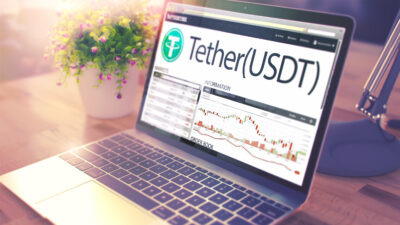EUnomics in the Age of Trump: Defense and Crypto Edition
Berlin-based economist Jan Philipp Fritsche explains how the new NATO defense spending pledge and US crypto legislation could impact the EU.

Sign up for smart news, insights, and analysis on the biggest financial stories of the day.
“Living next to you is in some ways like sleeping with an elephant,” Pierre Trudeau, the late Canadian prime minister, told a Washington, D.C., audience in 1969. “No matter how friendly and even-tempered is the beast, if I can call it that, one is affected by every twitch and grunt.”
More than 50 years later, those words still ring true far beyond Canada. In just six months, President Trump’s second administration has pursued a dramatic overhaul of economic policies with seismic implications both in the US, the world’s biggest market, and for the nation’s trading partners and competitors abroad. Take, for example, the European Union.
Under pressure from Trump’s administration, members of the NATO defense alliance, 23 of whose 32 members are EU countries, agreed last month to spend the equivalent of 5% of their national GDP on defense by 2035, up from the current 2% target.
And on Thursday, US lawmakers passed the GENIUS Act, the first major national crypto legislation, establishing a regulatory framework for stablecoins two years after the EU enacted its own legislation.
Few people have an inside understanding of one of these two macroeconomic changes: Berlin-based economist Jan Philipp Fritsche has a window into both. A former European Central Bank researcher who served on a panel supporting the European Parliament’s Committee on Economic and Monetary Affairs during the COVID pandemic, he is now the managing director at Oak Security, a leading cybersecurity firm that audits blockchains.
That unique career trajectory is afforded by the fact that he’s the rare economist who can audit code. “I specialize in teaching computers to run complex models quickly and analyze large datasets to drive decision-making,” he explains, something that’s allowed him to “contribute directly to audits, spotting vulnerabilities and flaws through an economist’s lens – a perspective too rarely applied to cybersecurity.”
He spoke to The Daily Upside at the Web3 Summit in the German capital on Friday about macroeconomic policymaking in the EU in the wake of the NATO pledge and what America’s new stablecoin law means for the Old Continent.
NATO’s Big Spend
The Daily Upside: In 2021, you published research on government spending in uncertain times: specifically, the impact of government spending shocks in the US. The headline takeaway was that fiscal policy, or the use of government spending to influence the economy, works. Positive government spending shocks prompt significant increases in output and private consumption. Why does this surprise people?
Jan Philipp Fritsche: There are a lot of reasons why people might be skeptical. The common argument goes like this: Governments take money away from individuals, hand it to bureaucrats who often lack market discipline, and then waste it on inefficient or even ridiculous projects. From that perspective, it’s easy to see why people doubt whether government spending can actually stimulate the economy.
But there’s a counterpoint that’s often overlooked. In the US, the government has access to extremely cheap funding and resources far beyond any private actor. That allows it to solve coordination problems that individuals or firms can’t. During a recession, private actors are often paralyzed by uncertainty — nobody wants to invest or spend because everyone’s waiting for someone else to move first. The government, however, doesn’t need to be anxious; it can step in decisively. By directing resources and creating demand, the state can effectively restart economic activity and help pull a country out of recession.
TDU: You also figured out that there’s one area where state spending doesn’t do much good from an economic perspective.
JPF: We figured out that an important thing to highlight is military spending. Because all the research papers that find the state is really inefficient, they look at military spending. And we also found that military spending was the least effective government spending within our research.
TDU: Why is that?
JPF: You’re not building infrastructure that can be used for other production. Military equipment or technology can’t be used as productively. When you invest in infrastructure like power plants, supercomputers, or even trucks, those assets have a productive value and can later be repurposed or sold — they also have multi-use value. By contrast, military equipment is highly specialized. It depreciates quickly, and if it’s called into action, it can literally detonate.
There are valid geopolitical and security considerations for military spending, but those were beyond the scope of our analysis. Our findings focus purely on economic impact.
TDU: It’s worth noting, then, that the NATO agreement to spend 5% of GDP on defense, up from 2%, means potentially spending hundreds of billions more on what you’ve found is economically inefficient.
JPF: From a purely economic perspective, it’s likely a bad investment. What that means is we likely have to do even more investment elsewhere to counteract that. It could be more infrastructure spending, and there can be synergies between military spending and other infrastructure spending. No-brainers, I think, for Europe are education and medical infrastructure. Those are areas where Europe has always excelled, and we could double down on that.
The GENIUS Effect
TDU: The GENIUS Act, America’s first major national crypto legislation, sets up a regulatory regime for stablecoins. Europe has its own legislation, the 2023 Markets in Crypto-Assets Regulation (MiCA), which you’ve been critical of. Where does the passage of the GENIUS Act leave Europe in relation to the US?
JPF: It’s a very clear signal that Europe needs to act now. I’ve criticized MiCA, which is not a great piece of legislation, for a while because it increases the too-big-to-fail risk for banks and it makes European-regulated stablecoins less competitive. The US now has the capacity to fund its budget with stablecoins, whereas Europe is behind.
TDU: Can you explain this to an American audience, who may not be familiar with how MiCA increases the risk for banks?
JPF: When you put fiat money into a stablecoin, the stablecoin has to do something with it. In the US, stablecoins do not need to deposit their funds with banks. They can invest their money in highly liquid assets, such as money market funds and treasuries. At the same time, money market funds have direct access to the central bank.
In Europe, however, the regulatory technical standards of MiCA basically require that up to 60% of a stablecoin’s funds be deposited with EU banks. So what does that mean? That means that 60% of the stablecoins could be at risk if a set of banks go bankrupt. And, to make this more explicit, this isn’t a theoretical case. We saw this happen when Silicon Valley Bank went bankrupt and Circle’s USDC broke its dollar peg because it had a $3.3 billion exposure.
And an important point of clarification: If you deposit money with a bank, like for a consumer, that’s insured by federal deposit insurance. But with a stablecoin, because the amounts being dealt in are so large, it’s not covered by federal deposit insurance. That’s why corporations have historically always relied on money market funds instead of banks.
You and fellow economist Jón Egilsson, the former chair of the Icelandic Central Bank’s supervisory board, have discussed this year how GENIUS offers potential support for dollarization, or the continued adoption of the US dollar in global transactions.
JPF: Totally. If a US corporation like Amazon launched a stablecoin under the new US framework, over time, we could have a lot of transactions in Europe denominated in US dollars. And look to Turkey, where we have already seen the dollar stablecoin Tether reach significant adoption. Even though Turkey is geographically so close to Europe, they aren’t using European stablecoins, they’re using US stablecoins.
TDU: What would you do to improve or fix MiCA?
JPF: First of all, you should not make banks the primary counterparty and central point of failure for stablecoins. Second, you should give money market funds access to ECB facilities. I think that’s basically how you could end up with a way to save the system. Even the ECB has a study on how money market funds that are exposed to bank risk are harder for them to stabilize. So, in a way, even the ECB has a paper that agrees with what I’m saying, even if the public stance of the ECB is very different toward stablecoins.
TDU: How do you convey this issue, which much of the public is genuinely unfamiliar with, to the average European? What are the consequences of potentially lagging US regulation, adoption, and innovation for them?
JPF: I would convey that the doomsday scenario is that everybody’s using denominated stablecoins under MiCA as it stands, and then we have a financial crisis where banks go bankrupt. Then, your stablecoin just halves in value, and nobody is insured, which would lead to a disastrous scenario where people’s balances are just cut in half. Then there’s another scenario where nobody’s using European stablecoins. Everybody’s just using dollar stablecoins. And then obviously you would always be exposed to US dollar fluctuations in Europe. And that would make us dependent on US macroeconomic policy.
And then what’s the best-case scenario? The other side is fixing the law. This will have a lot of advantages. We could have better financial infrastructure and easier payments. In Germany, you can’t even pay with a credit card in a lot of places. On a larger scale, euro-denominated stablecoins could spread globally, strengthening the euro’s role as a reserve currency. This would even give Europe more flexibility to fund new spending needs, like meeting NATO commitments, in the same way the US funds its debt through dollar dominance. It all ties together.











